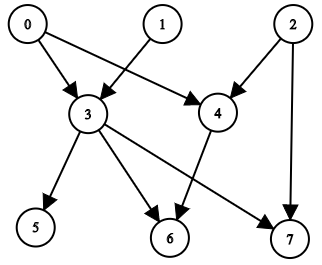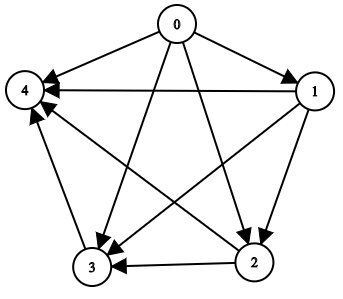2192. All Ancestors of a Node in a Directed Acyclic Graph


Description
You are given a positive integer n representing the number of nodes of a Directed Acyclic Graph (DAG). The nodes are numbered from 0 to n - 1 (inclusive).
You are also given a 2D integer array edges, where edges[i] = [fromi, toi] denotes that there is a unidirectional edge from fromi to toi in the graph.
Return a list answer, where answer[i] is the list of ancestors of the ith node, sorted in ascending order.
A node u is an ancestor of another node v if u can reach v via a set of edges.
Example 1:

Input: n = 8, edgeList = [[0,3],[0,4],[1,3],[2,4],[2,7],[3,5],[3,6],[3,7],[4,6]] Output: [[],[],[],[0,1],[0,2],[0,1,3],[0,1,2,3,4],[0,1,2,3]] Explanation: The above diagram represents the input graph. - Nodes 0, 1, and 2 do not have any ancestors. - Node 3 has two ancestors 0 and 1. - Node 4 has two ancestors 0 and 2. - Node 5 has three ancestors 0, 1, and 3. - Node 6 has five ancestors 0, 1, 2, 3, and 4. - Node 7 has four ancestors 0, 1, 2, and 3.
Example 2:

Input: n = 5, edgeList = [[0,1],[0,2],[0,3],[0,4],[1,2],[1,3],[1,4],[2,3],[2,4],[3,4]] Output: [[],[0],[0,1],[0,1,2],[0,1,2,3]] Explanation: The above diagram represents the input graph. - Node 0 does not have any ancestor. - Node 1 has one ancestor 0. - Node 2 has two ancestors 0 and 1. - Node 3 has three ancestors 0, 1, and 2. - Node 4 has four ancestors 0, 1, 2, and 3.
Constraints:
1 <= n <= 10000 <= edges.length <= min(2000, n * (n - 1) / 2)edges[i].length == 20 <= fromi, toi <= n - 1fromi != toi- There are no duplicate edges.
- The graph is directed and acyclic.
Solution
all-ancestors-of-a-node-in-a-directed-acyclic-graph.py
class Solution:
def getAncestors(self, n: int, edges: List[List[int]]) -> List[List[int]]:
graph = collections.defaultdict(list)
visited = [False] * n
p = collections.defaultdict(set)
for x, y in edges:
graph[y].append(x)
def go(node):
if visited[node]:
return p[node]
visited[node] = True
parents = set()
for parent in graph[node]:
parents |= go(parent)
parents.add(parent)
p[node] = parents
return parents
for node in range(n):
if not visited[node]:
go(node)
res = []
for i in range(n):
res.append(sorted(list(p[i])))
return res